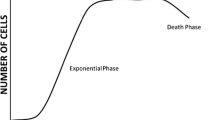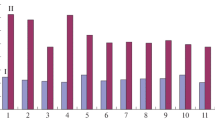Summary
The Mishell-Dutton culture system for in vitro primary antibody response of mouse spleen cells was used to optimize the amino acid composition of RPMI 1640 media. Each of the 20 amino acids was tested over a broad range of concentrations always leaving the remaining 19 amino acids unaltered (i.e. at the formula recommended concentration). In several instances, higher plaque-forming cell responses were obtained with an amino acid concentration that was either higher or lower than that recommended: (a) the optimum concentration for valine, glutamine, and lysine lies considerably above the recommended one, (b) the optimum concentration for leucine as well as for several other amino acids lies below the recommended concentration, and (c) the optimum concentration for arginine corresponds exactly to the recommended concentration. The second round of optimization, i.e. combining of two conditions that individually yielded an improved response often caused a decrease of response. The possibility is discussed that for an optimal response a ratio of two or several amino acids rather than the absolute concentration of any one amino acid is of importance.
Similar content being viewed by others
References
Mishell, R. I.; Dutton, R. W. Immunization of dissociated spleen cell cultures from normal mice. J. Exp. Med. 126: 423–442; 1967.
Moore, G. E.; Gerner, R. E.; Franklin, H. A. Culture of normal human leukocytes. JAMA 199: 519–524; 1957.
Schreier, M. H.In vitro immunization of dissociated murine spleen cells. In: Lefkovits, I.; Pernis, B., eds. Immunological methods. New York: Academic Press; 1979: 327–334.
Iscove, N. N.; Melchers, F. Complete replacement of serum by albumin, transferrin and soybean lipid in cultures of lipopolysaccharide-reactive B lymphocytes. J. Exp. Med. 147: 923–933; 1978.
Burger, M. A serum-free medium for the Mishell-Dutton system. Eur. J. Immunol. 7: 906–908; 1977.
Cunningham, A. J.; Szenberg, A. Further improvements in the plaque technique for detecting single antibody-forming cells. Immunology 14: 599–606; 1968.
Jerne, N. K.; Henry, C.; Nordin, A. A.; Fuji, H.; Koros, A. M. C.; Lefkovits, I. Plaque forming cells, methodology and theory. Transplant. Rev. 18: 130–191; 1974.
McKeehan, W. L.; Adams, P. S.; Rosser, M. P. Modified nutrient medium MCDB 151, defined growth factors, cholera toxin, pituitary factors, and horse serum support epithelial cells and suppress fibroblast proliferation in primary cultures of rat ventral prostate cells. In Vitro 18: 87–90; 1982.
Ham, R. G. Handbook of experimental pharmacology. Springer-Verlag, Berlin, New York; 57:13–88; 1981.
Click, R. E.; Benck, L.; Alter, B. J. Enhancement of antibody synthesisin vitro by mercaptoethanol. Cell. Immunol. 3: 155–160; 1972.
McKeehan, W. L.; McKeehan, K. A. Growth factor control of cell proliferation by control of cellular nutrient requirements. In: Steinberg, Ch. M.; Lefkovits, I., eds. The immune system. Basel: Karger; 1981: 383–390.
Click, R. E.; Benck, L.; Alter, B. J. Immune response in vitro. I. Culture conditions for antibody synthesis. Cell Immunol. 3: 264–276; 1972.
Seegmiller, J. E.; Watanabe, T.; Schreier, M. H. The effect of adenosine on lymphoid cell proliferation and antibody formation. In: Purine and pyramidine metabolism. CIBA Foundation Symp.; Elsevier/North, Holland/Amsterdam: Excerpta Medica; 1977: 249–276.
Butler, M.; Thilly, W. G. MDCK microcarrier cultures: seeding density effects and amino acid utilization. In Vitro 18: 213–219; 1982.
Griffiths, J. B.; Pirt, S. J. The uptake of amino acids by mouse cells (strain LS) during growth in batch culture and chemostat culture: The influence of cell growth rate. Proc. R. Soc. Lond. [Biol.] 168: 421–438; 1967.
Howard, M.; Kessler, S.; Chused, T.; Paul, W. E. Long-term culture of normal mouse B lymphocytes. Proc. Natl. Acad. Sci. USA 78: 5788–5792; 1981.
Quintans, J.; Lefkovits, I. Clones of antibody-forming cells in pokeweed mitogen stimulated cultures. II. Estimation of the frequency of precursor cells and the average clone size. Eur. J. Immunol. 4: 617–621; 1974.
Melchers, F. B-lymphocyte development and growth regulation, Clarkson, B., Marks, P. A., and Till, J. E. eds. In: Differentiation of normal and neoplastic hematopoietic cells. Cold Spring Harbor Laboratory, Long Island, NY, 1978: 485–503.
Author information
Authors and Affiliations
Additional information
The Basel Institute for Immunology was founded and is supported by F. Hoffman-La Roche & Co., Ltd.
Rights and permissions
About this article
Cite this article
Zhu, D., Lefkovits, I. Optimization of the culture medium composition for the antibody response of mouse spleen cells. In Vitro 20, 615–622 (1984). https://doi.org/10.1007/BF02619610
Received:
Accepted:
Issue Date:
DOI: https://doi.org/10.1007/BF02619610




